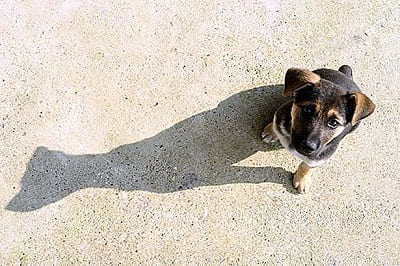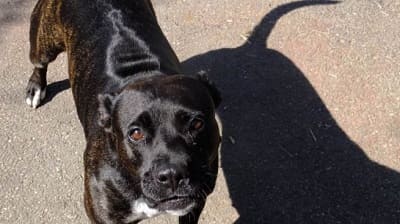My dog chases shadows: Why does he do this?
Have you watched your dog try to catch a shadow? Maybe if you have only seen it once, the fact has been a funny anecdote. However, if this is repeated, you should stop to think why my dog chases shadows, since you have to find a solution to what is hidden behind it.

What are compulsive behaviors in dogs?
A compulsive behavior in dogs is the impulse that leads them to carry out an action in a repetitive and invariable way. These actions also do not usually have any final purpose, but the dog will repeat it ad nauseam.
So much so that they dedicate hours and hours to this behavior, interfering in their daily routine and even, in some cases, in their health. The dog may become exhausted, lose weight, or injure himself.
There are many types of compulsive behaviors in dogs, also called stereotypes. If my dog is constantly chasing shadows, we must accept that something is wrong with him.
Causes why my dog chases shadows
Any dog can end up chasing shadows as a compulsive attitude. However, it is often said that shepherd dogs tend to have more predisposition to it because their instinct prompts them to try to gather all the shadows to have them under their control.
Having clarified this, it can be said that the main causes that usually trigger this behavior can be anxiety, stress or frustration, for various reasons.
Natural hunting instinct
Although this instinct is more ingrained in other domestic animals, such as cats, dogs can also begin to chase shadows because they want to give free rein to this instinct.
This happens especially in those races that by themselves have a hunting nature, whether they now develop that activity or not.

Lack of physical or mental stimuli
When the dog lives in a very small space and does not go outside enough, compulsive behaviors may appear in it, as it will seek by all means a stimulus.
It also happens when the dog does not play enough or does not interact with his guardians. The animal will find in the shadows an element that sometimes moves (for example, the shadow of the curtains with the wind) and it will become a game, something to catch.
However, a shadow cannot be caught, so anxiety and frustration will increase in the animal.
Empowerment of the problem
Sometimes, it is the owners themselves who end up enhancing the problem. Imagine that you have started to encourage your pet to chase the shadow of a certain object. It’s been a fun time for both of you, but the effect on you is different than your dog.
You will continue with your life, while your dog will want to repeat that behavior because he has had fun and because he has had your full attention. If you keep playing this game, there may come a time when the animal just wants to chase shadows.
Go to a professional
If you feel that the problem has gotten out of hand, do not hesitate to contact a canine ethologist to be able to solve this behavior. This will evaluate the case and begin to work with the dog certain guidelines so that he stops chasing shadows, as well as that he will give you the necessary advice so that you can help him too.
